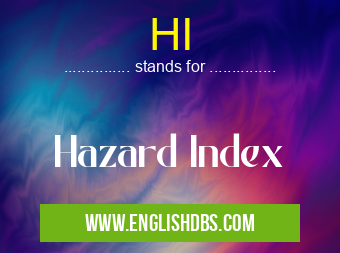What does HI mean in UNCLASSIFIED
HI (Hazard Index) is a measure of the potential health risks associated with exposure to a chemical or other hazardous substance. It is calculated by dividing the estimated exposure to the substance by the reference dose (RfD) or reference concentration (RfC) established by a regulatory agency such as the United States Environmental Protection Agency (EPA).

HI meaning in Unclassified in Miscellaneous
HI mostly used in an acronym Unclassified in Category Miscellaneous that means Hazard Index
Shorthand: HI,
Full Form: Hazard Index
For more information of "Hazard Index", see the section below.
Understanding Hazard Index
The RfD or RfC represents the maximum acceptable level of exposure to the substance without causing adverse health effects. If the HI is less than 1, it is generally considered that there is an acceptable level of health risk from exposure to the substance. However, if the HI is greater than 1, it indicates that there is a potential for adverse health effects and further evaluation is needed.
Significance of HI
HI is a useful tool for assessing the potential health risks associated with exposure to hazardous substances in various settings, including:
- Environmental contamination
- Occupational exposures
- Consumer product use
- Chemical spills or releases
By understanding the HI, decision-makers can determine whether further action is necessary to reduce exposure and protect human health.
Essential Questions and Answers on Hazard Index in "MISCELLANEOUS»UNFILED"
What is Hazard Index (HI)?
Hazard Index (HI) is a measure used in risk assessment to determine the potential health effects of exposure to multiple hazardous substances. It is calculated by adding the ratios of exposure levels to their respective reference doses or concentrations.
How is Hazard Index (HI) calculated?
HI is calculated by summing the Hazard Quotients (HQs) for each hazardous substance: HI = HQ1 + HQ2 + ... + HQn, where HQ = Exposure Level / Reference Dose.
What does a Hazard Index (HI) value indicate?
HI values less than 1 indicate that the combined exposure to multiple hazardous substances is unlikely to cause adverse health effects. HI values greater than 1 suggest a potential for adverse health effects, and further evaluation is warranted.
Why is Hazard Index (HI) important?
HI helps assess the cumulative health risk posed by exposure to multiple hazardous substances. It is particularly useful when evaluating exposures from various sources, such as contaminated soil, air, and water.
How is Hazard Index (HI) used in decision-making?
HI is used in conjunction with other risk assessment tools to make decisions regarding exposure limits, remediation actions, and public health protection measures. It provides insights into the potential health risks associated with multiple chemical exposures.
Final Words: HI (Hazard Index) is an important measure that provides insights into the potential health risks associated with exposure to hazardous substances. By calculating the HI and comparing it to acceptable levels, individuals and organizations can make informed decisions to mitigate health risks and ensure a safe and healthy environment.
HI also stands for: |
|
| All stands for HI |
